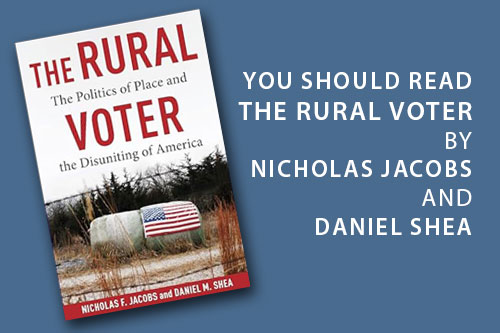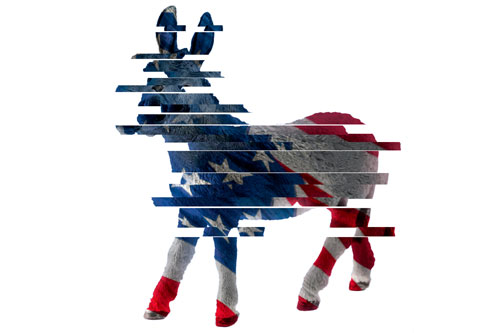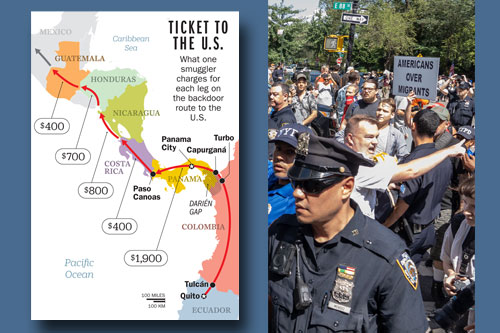I know there’s a lot of scary stuff in the air about Donald Trump’s second-term plans. But there is one agenda item that is unusually well-defined and a real electoral challenge and opportunity for Democrats, as I explained at New York:
Donald Trump’s recent reference to his political enemies as “vermin” is a reminder that while we should be cautious about comparisons between the 45th president and the most notorious fascists of the 20th century, there are times when nothing else suffices. That’s certainly true of Trump using such dehumanizing rhetoric for his fellow Americans. And it’s also true of Trump’s appalling immigration-policy proposals for his second term, which truly sounds like something you’d expect to see in an authoritarian dictatorship rather than in the modern-day United States.
The New York Times recently reported that if reelected, Trump plans to round up, incarcerate and then deport millions of undocumented immigrants. In recent decades there has been plenty of talk among Republicans about sealing off the southern border, reducing both legal and illegal immigration, and deporting selected groups of immigrants deemed a threat to national security. But aside from those living in the fever swamps of racist xenophobia, nobody has proposed mass deportations of people who have been living and working peacefully in America for years.
That will clearly change if Trump wins a second term and returns former Breitbart News rabble-rouser Stephen Miller to the helm of the government’s immigration policies, per the Times:
“Former President Donald J. Trump is planning an extreme expansion of his first-term crackdown on immigration if he returns to power in 2025 — including preparing to round up undocumented people already in the United States on a vast scale and detain them in sprawling camps while they wait to be expelled …
“He plans to scour the country for unauthorized immigrants and deport people by the millions per year.
“To help speed mass deportations, Mr. Trump is preparing an enormous expansion of a form of removal that does not require due process hearings. To help Immigration and Customs Enforcement carry out sweeping raids, he plans to reassign other federal agents and deputize local police officers and National Guard soldiers voluntarily contributed by Republican-run states.”
This isn’t some surreptitious plan that reporters have dug out from obscure sources. Miller is publicly chortling about the audacity of what he intends to do, as the Times notes:
“Stephen Miller, a former senior Trump administration official who led Trump’s immigration policy, told The Times, ‘Any activists who doubt President Trump’s resolve in the slightest are making a drastic error: Trump will unleash the vast arsenal of federal powers to implement the most spectacular migration crackdown.’
“Miller told The Times that Trump’s immigration plans are being designed to avoid having to create new substantial legislation. During Trump’s first term, he relied heavily on executive orders to implement immigration policy. Many of those moves were challenged in the courts, something Miller acknowledged would be likely to happen again in a second Trump term.”
We’ll get to see, in other words, whether Trump’s judicial appointments and more competent lawyering can help him achieve a different result in his new term than he did with his less aggressive first-term agenda.
There’s no doubt the political climate on immigration policy has changed since Trump was first elected president in 2016. For one thing, the salience of immigration as a voting issue dropped significantly between 2016 and 2020. And it was clearly a topic that hurt Trump’s second campaign even though he wasn’t raging about it constantly, as a 2020 Election Night survey from Public Opinion Strategies found:
“The Public Opinion Strategies poll makes clear that President Trump’s immigration policy was a political loser by a double-digit margin and cost him a substantial vote share. Voters across the political spectrum want to reform our nation’s immigration system, centered on a pathway to citizenship for undocumented immigrants.”
Now, thanks to massive publicity (particularly in conservative media) about migrants at the southern border, immigration policy matters more than it did in 2020. According to recent battleground-state polling from New York Times/Siena, voters trust Trump more than Biden on immigration policy. It’s simply a better environment for Trump to propose an immigration crackdown. However, it’s unclear whether voters have any idea of how far Trump wants to go in inaugurating Gestapo-style policies to track down, arrest, transport, and deport millions of people from communities all over the country. But it’s not ambiguous at all. Once they know about Trump’s plans, the Latino voters who have been trending Republican in recent elections will likely bridle at the racial and ethnic profiling by federal, state, and local law-enforcement officials that will inevitably accompany any effort to “scour the country for unauthorized immigrants,” as the Times puts it.
Team Biden may be tempted to ignore immigration policy as a “loser” for the incumbent president. But if they do, they will be missing an opportunity to let voters know how scary Trump’s plans are. He’s using concerns about migrants to justify the most massive reversal of U.S. immigration practices at least since Dwight D. Eisenhower’s openly racist “Operation Wetback” deportation drive in the 1950s (which Trump has often praised). Biden and Democrats need to stop thinking of immigration as a Republican issue and explain to voters just how radical Trump is on the subject. It’s encouraging that the Biden campaign has already come out with an attack on Trump’s plan, calling it an “extreme and rapid expansion of his first-term clampdown on immigration if he takes back the White House,” as Politico put it. But they need to keep it up. It’s a really big deal not just for people directly affected by immigration policy but for anyone who wants to block a lurch into authoritarianism.









